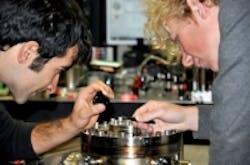Laser beam technique makes microscope 20 times more sensitive
Physicists from the Australia National University’s Quantum Optics Group of the Research School of Physics and Engineering have developed a technique that utilizes laser beams to make atomic-force microscope probes 20 times more sensitive.
The technique involves the cooling of a nanowire probe to -265°C using laser beams. By cooling it to this temperature, the level of sensitivity achieved is accurate enough to sense the weight of a large virus that is 100 billion times lighter than a mosquito, according to Professor Ping Koy Lam, the leader of the Quantum Optics Group.
A news release from the Australia National University explains that this development could be used to improve the resolution of atomic-force microscopes, which are used to measure nanoscopic structures and the tiny forces between molecules. These microscopes are able to achieve sensitive measurements of microscopic features by scanning a wire probe over a surface, but the probes—which are about 500 times finer than a human hair—are prone to vibration at room temperature, which can lead to noisy measurements.
By shining lasers at the probe, explained research paper co-author Dr. Ben Buchler, they are able to stop this motion. By controlling this warping effect, the team was able to use the effect to counter the thermal vibration of the of the probe, added PhD student and team member Giovanni Guccione.
However, the probe can’t be used while the laser is on, as the effect overwhelms the sensitive probe. As a result, the laser has to be turned off and any measurements must be made quickly before the probe heats up. Measurements are made over a number of cycles of heating and cooling called periodic quiescence feedback cooling, and improved signal-to-noise ratios for the measurement of transient signals are obtained.
The results obtained through this research could be potentially beneficial in such applications as biosensing, molecular metrology, subsurface imaging, and accelerometry.
View the news release.
Also check out:
MICROSCOPY : Confocal microscope employs digital light projector
Vision-guided robot speeds optical filter analysis
Vision system measures intensity of photosynthesis in plants
Share your vision-related news by contacting James Carroll, Senior Web Editor, Vision Systems Design
To receive news like this in your inbox, click here.
Join our LinkedIn group | Like us on Facebook | Follow us on Twitter | Check us out on Google +
About the Author

James Carroll
Former VSD Editor James Carroll joined the team 2013. Carroll covered machine vision and imaging from numerous angles, including application stories, industry news, market updates, and new products. In addition to writing and editing articles, Carroll managed the Innovators Awards program and webcasts.
